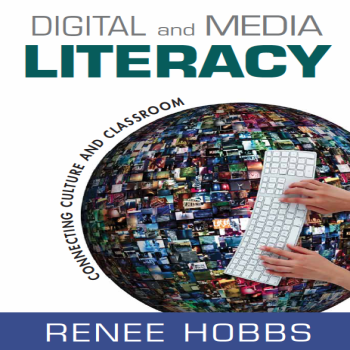
This book introduces educators to the practice and theory of digital and media literacy education in secondary schools.
A Review by John Robinson
How can teachers use digital and media to support academic achievement in all subjects and content areas? The answer to that question is essentially what Renee Hobbs tackles in her book Digital and Media Literacy: Connecting Culture and Classroom.
Hobbs begins answering the question of supporting academic achievement with digital and media by outlining the rationale for engaging these two in 21st century instruction. Basically, that rationale includes: Digital and media motivates students and that makes them a means to reach today's learners. Our students today have digital and media needs: 1) They need knowledge and guidance in using digital and media effectively, 2) They need to know how to evaluate the multitude of digital and media messages they receive, and 3) They need the integrity and ethical center to be good citizens in their use of digital and media. After providing the rationale for using digital and media to support learning, Hobbs then turns to describing what she calls "A Process Model for Digital and Media Literacy." This process model she describes involves "5 Communication Competencies or Steps" that can employed across all content areas. These are what she terms as "the essential dimensions of digital and media literacy."
1. ACCESS: According to Hobbs, "access" is the first step in digital and media literacy. It involves "finding and sharing appropriate and relevant information using media texts and technology tools. Students need to be able to effectively locate and identify relevant information to the task or issue with which they are engaged. To do that, they need access competencies.
2. ANALYZE: This second step Hobbs points to involves "using critical thinking to analyze message purpose, target audience, quality, veracity, credibility, point of view, and potential effects or consequences of messages." In other words, students need to be able examine the messages and information they receive from digital and media and analyze for the common components of rhetoric and communication. This competency makes students effective consumers as well as conveyors of digital and media messaging.
3. CREATE: The third step involves "composing or generating content using creativity and confidence in self-expression, with awareness of purpose, audience, and composition techniques into the world of digital and media." Students need to be able to not only effectively consume information, they also need to be able to be effective content creators in digital and media. In the 21st century, with all the myriads of digital tools available, those who excel are content generators, so our students need this competency as well.
4. REFLECT: Reflecting involves examining the impact of media messages and technology tools on our thinking and actions in daily life. It also involves "applying social responsibility and ethical principles to our own identity, communication behavior, and conduct." Students need to reflect on the digital and media messages they send and think about the effects of these on their lives. This skill of reflection helps our students become humane consumers and creators of digital and media content.
5. ACT: The fifth and final step or competency is "working individually or collaboratively to share knowledge and solve problems in the family, the workplace, and the community." It means participating in local and global communities. According to Hobbs, this step involves getting students in the classroom connected to the world, providing support for their leadership development and collaboration, and developing integrity and accountability as they take their place as global citizens. Students need to engage in using digital and media in solving problems and at the same time take advantage of global connectivity. Because the 21st century world is a much smaller place, our students need to be able to "act" using their digital and media skills.
Throughout the remainder of Digital and Media Literacy, Renee Hobbs expands these steps or communication competencies and provides extensive discussion and information on the implementation and incorporation of them into the classroom and across subject areas. Each chapter is structured to take a closer look at these 5 dimensions or competencies, and how they might look in the classroom. Hobbs' book is a must-read for teachers, administrators, and district as well as state education leaders who are trying to tackle the question, "What do we do with students with all this digital and media?"
Other strengths of this book include:
- A thorough and comprehensive review of what digital and media literacy should look like in classrooms and in all content areas.
- A practical implementation knowledge with sample lessons that can be used to design learning that captures all 5 of the digital and media competencies or steps.
- A review of the 5 challenges teachers face when trying to "develop student voice in digital and media formats."
- A powerful, concise discussion of digital citizenship and on becoming ethical digital and media consumers and creators.
- Useful information on how to incorporate current events into classroom activities.
- Some focus on how to engage in what Hobbs calls "Responsive Teaching."
I've read a great deal on the topic of digital and media technologies and how to integrate those into instruction, but Digital and Media Literacy: Connecting Culture and Classroom provides something unique. First, it gives educators a framework of digital and media competencies and shows them how to engage students in learning those competencies using the technologies. Secondly, it provides examples of real classroom practice through narratives and sample lesson plans. Finally, its focus on implementation makes it great for a book study by a faculty wanted to explore how to use digital and media the way it should be used in the classroom.
Digital and Media Literacy is a must read for district and state leaders, classroom teachers, technology directors, and anyone interested in how we can embrace the enormous task of using digital and media to support academic achievement in the classroom.